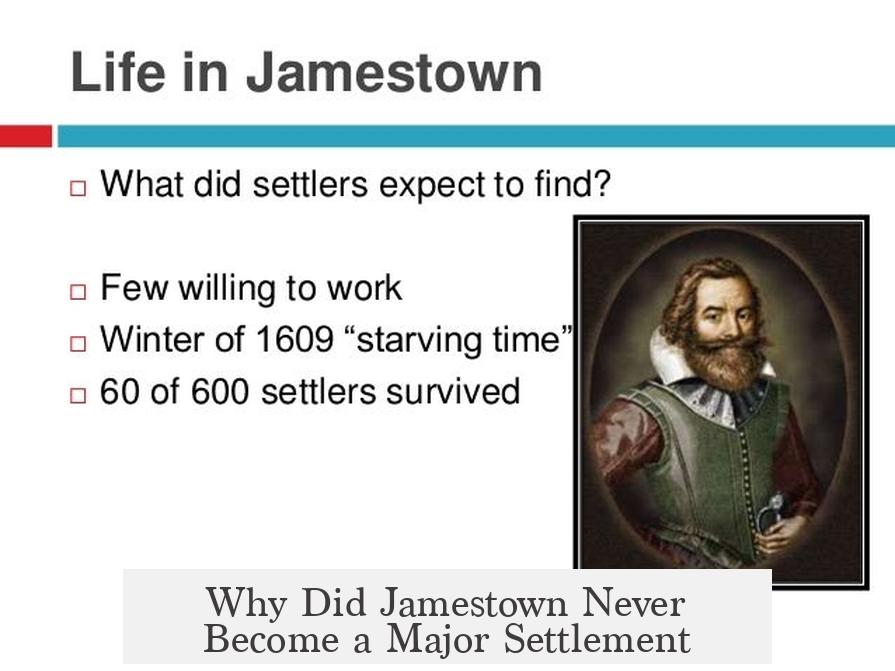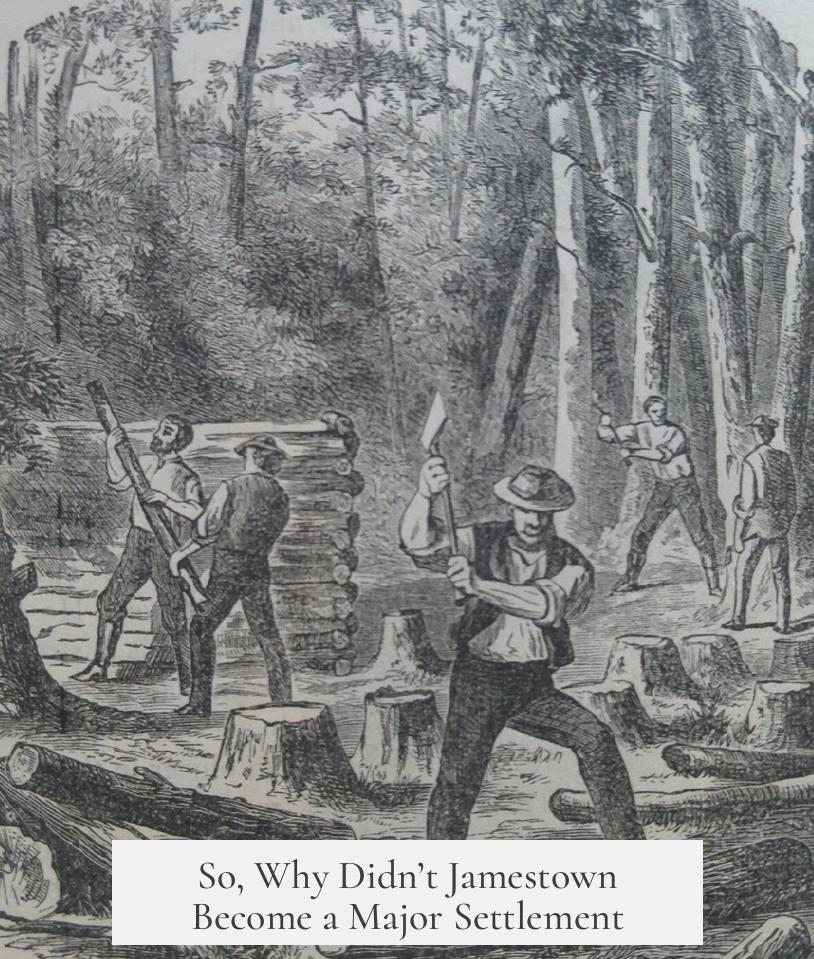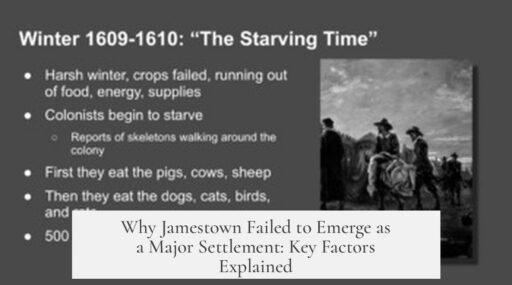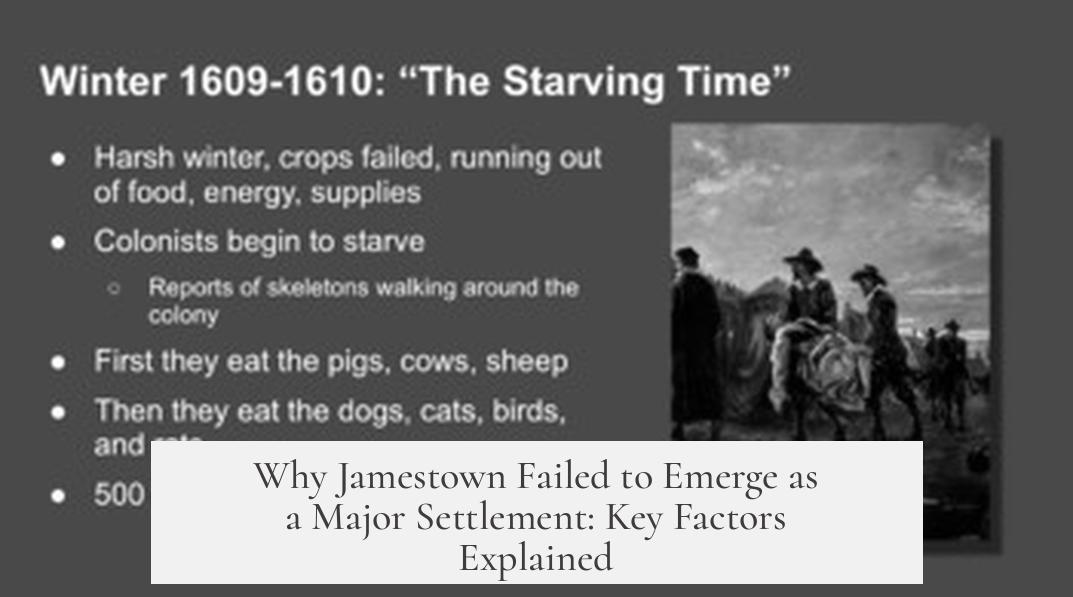Jamestown never became a major settlement due to repeated hardships, attacks, and eventual loss of political status. The colony faced severe challenges from its inception, which hindered its growth and led to gradual abandonment.
Hostile relations with Native Americans marked Jamestown’s early years. Soon after arrival, settlers were attacked by the Powhatan tribe. This conflict persisted, worsening conditions. The winter of 1609-1610, known as Jamestown’s darkest hour, saw only 60 out of 300 settlers survive due to siege, famine, and disease.
The colony’s difficulties continued into the late 17th century. In 1676, Nathaniel Bacon led a rebellion that resulted in Jamestown being sacked and burned. Although the settlement remained Virginia’s capital, the damage slowed its recovery. Later, in 1698, a fire destroyed the statehouse, further weakening the town’s political and economic standing.
Jamestown lost status when the capital moved to Williamsburg. This was a critical turning point. Williamsburg offered a larger, safer, and more stable environment for settlers and government functions. The relocation led many to leave Jamestown.
By the 1750s, Jamestown was nearly deserted. Only two families remained, converting the area into farmland. The settlement never regained its former importance or population.
| Factor | Impact on Jamestown |
|---|---|
| Hostile Native Relations | Frequent attacks, high settler mortality |
| Winter of 1609-1610 | Massive deaths, settlement survival threatened |
| Bacon’s Rebellion (1676) | Town sacked, slowed growth |
| Statehouse Fire (1698) | Political center damaged, decline accelerated |
| Capital Moved to Williamsburg | Loss of political and economic importance |
| Abandonment | Population decline, turned to farmland |
- Jamestown faced ongoing attacks causing high settler deaths.
- Major events like Bacon’s Rebellion and the 1698 fire caused setbacks.
- The capital’s relocation to Williamsburg shifted political power.
- By mid-18th century, Jamestown was mostly abandoned.
Why Did Jamestown Never Become a Major Settlement?

Here’s the short answer: Jamestown never became a major settlement due to a brutal mix of hostile relations, deadly setbacks, and eventual abandonment when better locations took the spotlight. But let’s break down exactly how things unfolded in this infamous colonial chapter.
Picture this: a group of 104 English settlers arrives in 1607, excited to start fresh. Instead, they step into a nightmare. Almost immediately, they face hostility from the local Powhatan Indians. Conflicts flare quickly—these weren’t your average neighborhood spats. The Powhatan attacks are relentless and deadly.
By the winter of 1609 to 1610, things looked even grimmer. Historians call this period Jamestown’s darkest hour. Out of 300 settlers, only 60 survive that brutal winter. Famine and disease join the harsh environment as key culprits. Attacks from Powhatan warriors didn’t relent, either, making survival a daily gamble.
Hostility at the Doorstep
Imagine setting up your new home only to be constantly under threat from neighbors who aren’t keen on you being there. These hostile relations eat away at the colony’s stability. The settlers are understaffed, under-resourced, and under siege, literally and figuratively.
Diseases such as dysentery and typhoid run rampant in the cramped, unsanitary environment, while famine gnaws at the community when crops fail or are destroyed during conflicts. Jamestown is less a thriving town and more a survival camp.
Setbacks That Put Out the Fire
Fast forward a few decades, and Jamestown is still struggling. In 1619, things looked up when the colony organizes Virginia’s first assembly. Big deal for democracy! New settlers keep coming, and the colony seems poised for growth. But then 1676 arrives with a historic punch: Bacon’s Rebellion.
Nathaniel Bacon leads a revolt against local authorities, frustrated by leadership and policies on the frontier. The rebellion ransacks Jamestown, burning much of the town to the ground. This violent upheaval decimates the settlement’s infrastructure and trust, deeply scarred for years.
Talk about a history of bad luck! If that wasn’t enough, the statehouse — the colony’s center for government — burns down in 1698. For a place already struggling, this is like losing the town hall, courthouse, and city library in one blaze. It’s a crippling blow, denting Jamestown’s status as Virginia’s capital.
Losing Capitol Status: The Final Buzzer
Repeated disasters might be bearable if there’s a silver lining. But when the capital shifts to Williamsburg in the early 18th century, Jamestown’s fate is sealed. Williamsburg offers a more stable, secure, and attractive location for governance and settlement. Jamestown, battered and burned, can’t compete.
By the 1750s, most settlers have moved on. Only two families remain, turning the once-bustling settlement into farmland. The ghost of Jamestown lingers, but the life and promise have left.
So, Why Didn’t Jamestown Become a Major Settlement?

- Hostile relations with native Powhatan Indians created danger and instability from day one.
- High mortality rates due to disease, famine, and attacks made it hard to build a thriving population.
- Repeated catastrophic events, like Bacon’s Rebellion and destructive fires, shattered infrastructure and morale.
- The relocation of the Virginia capital to Williamsburg pulled political and economic life away from Jamestown.
- Eventual desertion left Jamestown a shadow of its former self, with few inhabitants and little purpose.
Think about it: Why would anyone stay after such relentless challenges? It’s kind of like living in a house that floods every time it rains, only to find a new, dry place down the street.
What Lessons Can We Learn?
Jamestown’s story is a reminder that location isn’t just about geography. It’s about security, resources, governance, and opportunity. Early settlers might have pushed through their darkest hours, but persistent setbacks make growth nearly impossible. Jamestown was just too fragile to turn into a major settlement.
Its legacy, however, stands strong. Jamestown represents the gritty, often grim reality of early colonial life. It paved the way for more successful towns like Williamsburg and later, the cities that shaped America.
Curious: Could Jamestown Have Survived If History Played Out Differently?
Speculating is fun! What if there had been peaceful relations with the Powhatans? What if Bacon’s Rebellion never happened? Or if the statehouse fire was avoided? Could Jamestown have evolved into a bustling city?
These “what-ifs” underline how fragile early colonies were and how a few key events can alter history’s path dramatically. Jamestown isn’t just a failed experiment; it’s a story of endurance and a warning about the challenges of colonial life.
In Closing
Jamestown faced a perfect storm of adversity and setbacks. It never became a major settlement because it was constantly battered by hostile forces, internal rebellion, devastating fires, and the strategic shift of colonial capital elsewhere.
Yet, its role as America’s first permanent English colony is undeniable. Even if Jamestown never grew into a major city, it laid crucial groundwork for what would become the United States. So while it may have been abandoned and overshadowed, Jamestown’s impact is anything but forgotten.




